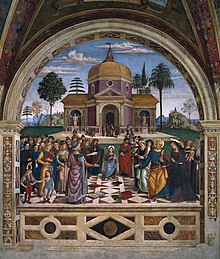Baglioni Chapel

|
| Cappella Baglioni |
|---|
| Pinturicchio , 1501 |
| fresco |
| Spello |
Coordinates: 42 ° 59 ′ 23.6 " N , 12 ° 40 ′ 19.9" E
The Baglioni Chapel is located in the Church of Santa Maria Maggiore in Spello and is known for the fresco cycle by Pinturicchio , which was created from 1500 to 1501.
history
The decoration was commissioned by Prior Troilo Baglioni (died 1506), later Bishop of Perugia , and is dated 1501, which is believed to be the completion of the work. The project was Pinturicchio's last major assignment in Umbria before moving to Rome and Siena . As is customary for the Perugian painter, the work was carried out at considerable speed thanks to a well-organized workshop and the collaboration of other masters who painted from his design.
In the second half of the 16th century the chapel was paved with Deruta ceramic tiles by the artist known as “the brother” .
1976-1977 a restoration took place and the chapel was equipped with an air conditioning system against moisture.
description
The chapel has a square floor plan with a cross vault . The frescoes show scenes from Mary and the childhood of Jesus. The vault in which the fresco ornamentation usually began contains four sibyls in the segments seated on thrones and flanked by tablets with prophecies about the coming of Christ. Largely damaged and painted over, the image version was probably made by Bartolomeo Caporali . The wide, grotesque candlesticks on the cross ribs are probably made by the same artist, as they are similar to those made in the church of Sant'Antonio Abate in Deruta .
The three main scenes, in the form of a bezel, occupy the three available walls and are surrounded by painted columns and arches from which one can see the jamb, divided by geometric decorations and rosettes and shortened from bottom to top, creating the illusion arises to be in a Greek cross with arms open to the outside.
Annunciation
The left wall shows the Annunciation , which stands in front of a majestic Renaissance loggia, whose perspective, geometric floor allows the beholder to wander into the distance, where a landscape full of details opens up beyond the Hortus conclusus . The main characters are quite conventional: Mary reading is surprised by the angel who approaches with a blessing and carries the white lily, symbol of her virgin purity, in his hand; above, eternity appears in an almond of little angels who send the dove of the Holy Spirit through a ray of light .
The right side seems particularly neat, where on one wall there is a small window with a grille and behind it an amphora, underneath a bookcase with a hanging painting that is nothing more than the self-portrait of the painter in a proud pose, complete with a dedication in a decorative plaque. (+ BERNARDINVS + PICTORICIVS PERVSINVS +).
Adoration of the Shepherds
The central wall shows the Adoration of the Shepherds , with the arrival of the kings in the background. The scene takes place on the lawn in front of the canopy, which, thanks to the perspective from below, takes on grandiose proportions, with a clear definition of all elements, from the enclosure with ox and donkey to the pack animals that are used on the journey. A small window opens in the wall from which one can see a clear landscape, a kind of painting within a painting. The shepherds in the foreground have somatic features cut and expressive based on the Flemish model , while the young man with the goat on the left, inspired by old reliefs with sacrificial themes, shows an idealized youthful beauty. The group of the Madonna and Child takes the form of the Adoration of the Shepherds, a fresco painted years earlier in the Nativity Chapel in Santa Maria del Popolo , Rome . Above is a choir of angels.
The background is very neat, with a city clearly painted down to the last detail, which has a miniature character. Among the symbolic elements there is a peacock on the canopy, a symbol of immortality.
Jesus discusses with the scholars
The right wall is adorned with Jesus' discussion with the scholars . The young Jesus is the fulcrum of the two groups of philosophers of the Temple of Jerusalem, which towers in the background with its dome. This is a scheme already used by Pinturicchio in the Bufalini Chapel , which in turn was derived from Perugino's handover of the keys in the Sistine Chapel . As usual, the building has a central floor plan and shows two niches with grotesque decorations and old statues, according to the ancient taste, of which Pinturicchio was one of the protagonists. The crowd consists of typical figures, young brides, wise men, toothless old men and simple bystanders. A few portraits protrude between them, including on the left that of Troilo Baglioni in the form of an apostolic protonary next to a gentleman with coins symbolizing the reward for Pinturicchio.
literature
- Giordana Benazzi (Ed.): Pinturicchio a Spello. La Cappella Baglioni in Santa Maria Maggiore . Silvana Editore, Milan 2000.
- Cristina Acidini : Pittori del Rinascimento . Scala, Florence 2004, ISBN 88-8117-099-X , Pintoricchio.



